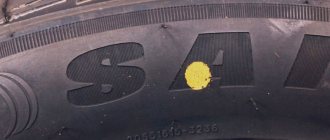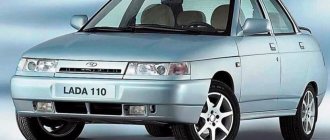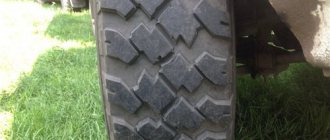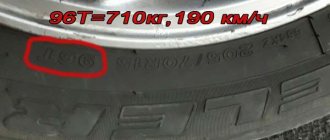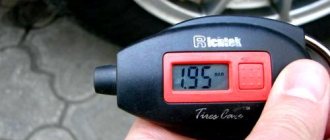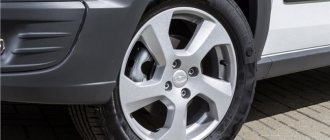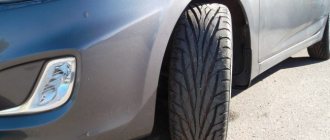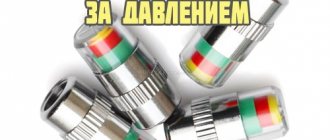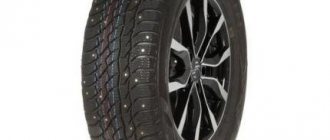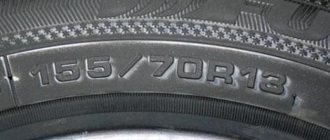Stripes can be of different widths, colors and locations. But they have one common characteristic feature. Please note: the stripe always goes along the entire circumference of the tire. This ensures that paint never gets into the grooves. What kind of painter is this who is not too lazy to paint like this “artistically” on each tire?
If the nozzle sprayed paint onto the rotating tire, the stripes would fit perfectly. And these are not applied quite evenly. Does this mean they are applied by hand?
If the nozzle sprayed paint onto the rotating tire, the stripes would fit perfectly. And these are not applied quite evenly. Does this mean they are applied by hand?
How are stripes useful for the buyer?
Tires are sometimes sold inconsistently, especially in markets, that’s a fact. I came across a situation where tires produced not only in different weeks, but also in different years were sold as one set. However, it is believed that it is better to install tires from the same batch on a car. This is where third time tire stripes can come in handy.
If the stripes on the tires are absolutely identical, this is an indirect sign that the tires are from the same batch.
If the stripes on the tires are absolutely identical, this is an indirect sign that the tires are from the same batch.
Colored spots on the side surface
On the sidewalls of the tire, in addition to the logo with the name of the manufacturer, the rubber model and its parameters, you can see colored marks in the form of round, square and triangular spots. The label can be either one or several symbols of different colors.
The most common designation that can be found in auto shops and warehouses is a round spot of red, yellow and white. This designation is applied during the initial balancing of tires by the manufacturer and is intended for the tire service worker so that he can correctly fit the tire on the wheel rim. There is no difference in whether the spot is round or triangular in shape. The color of the spot itself plays an important role.
The red spots indicate the heaviest point of the tire where maximum radial force deflection occurs. The very concept of “radial force” is used in calculating the dynamic and mechanical properties of a tire, to produce the highest quality and uniform tires. As you know, a tire is a technically complex product consisting of many different layers of rubber. And the radial force, in turn, shows with what force elastic elements of different stiffness are compressed and repelled during tire rotation.
On some rims you can find the designation “L”, which indicates its lightest point. In addition to the letter "L", it can be a colored dot. Using these designations, a tire shop worker is guided when installing a tire on a rim. When the disk does not have marks, you need to navigate by the nipple. In the case of a red dot on the sidewall, it should coincide with the designation of the light point of the disk, or if the disk does not have designations, it should be opposite the nipple. Typically, such red dots can be found on tires that come with a new car.
The yellow dots on the tires indicate the lightest and weakest point. When installing a tire, the yellow mark is located opposite the weak point mark of the wheel rim or opposite the valve when it is missing. With this arrangement, as a result of heavy loads, the disk and tire will be maximally protected from damage, and the impact will be less transmitted to the suspension.
The white dot indicates that the area where it is applied is the most flexible and the radial force deflection is minimal. In the same case as with the yellow spot, the white dot should be located opposite the wheel rim mark or coincide with the nipple.
In addition, you can find similar green or blue dots on tires. They must correspond to the red and yellow designations, but in any case, universally approved colors must be used to indicate tire parameters. This is usually the work of manufacturers who want to confuse their customers by making smart advertising moves to satisfy their personal gain. Therefore, before purchasing, you should definitely consult the seller and ask him to explain the meaning of each mark.
Thus, applying such marks will make it possible to correctly seat the tire on the rim and carry out balancing, while spending a small amount of balancing weights. At the same time, a savvy driver who has information about how the tire should fit correctly will be able to verify the quality work of his technician.
What do red dots and triangles on tires mean?
A red dot on a new tire is also common. What does it mean for the user? This is the heaviest part of the tire and is also the toughest. Similar to the recommendations for the yellow mark, the red one should be aligned with the letter “L” on the disk, or placed opposite the valve.
Red dots are most often found on tires that are equipped with cars during factory assembly. In this case, the original disks in a certain place are marked with white dots. These two marks must be aligned with each other. However, car owners in normal tire fitting conditions should be guided only by the yellow icons, placing them near the air valve. The red dots are for mounting the tires on the rims during the initial assembly of the car.
How to choose winter tires for a car: tips and warnings
How and which one to choose winter tires? This question is asked by many car owners before the onset of winter. The cost of a set of winter tires is quite high, but every driver wants the car to have the best grip on the road and to be comfortable driving the car. Therefore, before choosing tires, understand this issue. How to determine whether it is with or without spikes? Should I take wide or narrow tires? Should I buy symmetrical, asymmetrical or directional tires? To make the right choice, follow these steps:
- You need to understand which type of tires is best suited to the type of climate in which you live: Scandinavian or European.
- Then decide on the manufacturer: branded wheels from Michelin, Pirelli, Bridgestone? Or well-proven tires in the mid-price segment Firestone, Kleber, Toyo? Budget Rosava? Do you drive a lot? Then you should buy the best quality tires.
- Decide how new the model should be. Compared to classic options, ultra-modern ones will cost much more. You can safely choose last year's models. But there is one drawback: there is a possibility that such tires are no longer produced, so replacing them will not be easy.
- Select specification. To do this, we look at what size and type of tires are suitable for your car model. You can find this information in the service book. You should purchase tires of the size that can be used on your car. With such wheels, driving a car will be as safe as possible.
- Select a tread pattern. It all depends on the conditions in which the car is operated. During the winter season, do you drive in the city on clean roads? Then the protector can be made in the form of small checkers. If you plan to drive on a snowy road, then the tread pattern should be aggressive.
- Compare speed indexes. As the index increases, the permeability of wheels on snow decreases. This principle works vice versa. If you plan to drive on dry asphalt in winter, then it is better to choose tires with a high speed index, because the braking distance will be shorter.
- Choose where to buy branded tires. The seller must be reliable so that you do not buy a fake.
- Conduct a visual inspection of the wheels. You can test the tires. It is clear that you will not be allowed to put a set of wheels on your car and drive it. What to do? We take a cloth glove with us. We run it in the direction of the tread pattern. Does the glove slip? This means the grip will be the best.
- Check the softness of the tires. We feel them: if the rubber bends, it means that the tires will remain soft even in severe frost.
- Find out the expiration date of the wheels. The specified date must be no more than 2 years. If the tires are already 3-4 years old, their quality may deteriorate. The date of manufacture is indicated on the side of the wheel.
- Study the labeling and ask the seller to provide a certificate of conformity. This document is proof that this type of tire can be used in our country.
How to choose winter tires to save money if your budget is limited? The best solution is to purchase a different tire size. You should follow the manufacturer's recommendations, but some exceptions can be made. The larger the profile size and the seat diameter, the more expensive the tires.
You can also choose winter tires with a lower speed index, then the price for a set of wheels will decrease significantly. For example, your car cannot go faster than 150 km/h. This means that you don’t need to buy wheels with a speed index greater than “P”.
In an effort to save money, one should not forget about quality. It is not recommended to purchase used wheels. Even if visually such tires look normal, the grip on the road will be worse than that of new winter tires. You can only use used tires for 1 season.
You can compromise and choose all-season tires. But this can only be done in European countries where the climate is mild and there are no severe frosts.
You cannot install only 2 winter tires. Can't afford to buy a set of winter wheels? Installing different types of tires is not a solution to this problem. Because driving a car with two summer and two winter wheels can be dangerous.
What does the white stamp with a number on tires mean?
Tires are also sometimes marked with a white mark. It can be a square, rhombus, circle or triangle. There is a number printed inside. This emblem is an analogue of the Soviet quality mark. A tire marked in this way has been precisely subjected to final quality control at the factory. Consequently, its operating parameters are within the values set by the manufacturer. Also, using this mark, you can identify the specific employee who carried out the quality control procedure for this tire.
